By Dylan Bickerstaffe. Published on Egyptological, Magazine Edition 9. 4th December 2013
Part 1 of the Significance of the Crossed Arm Pose on Egyptological can be found here.
General Introduction
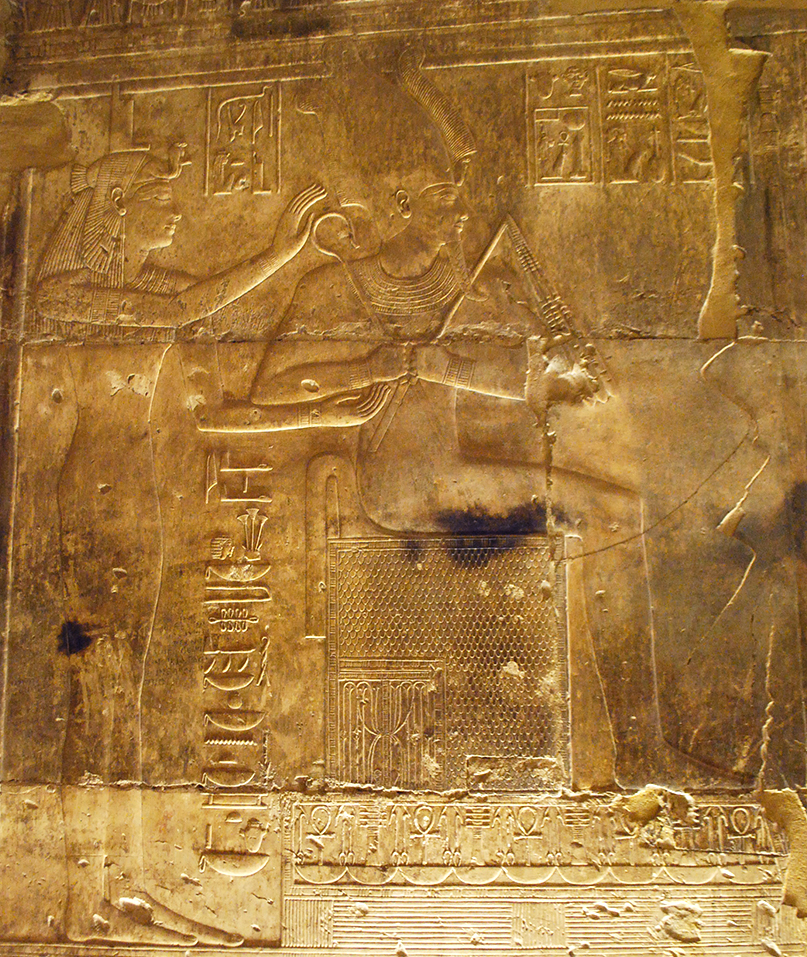
Seti Temple, Abydos. This scene shows the classic Osiris pose, arms “opposing.” Osiris wears the Atef crown and is supported by Isis
Is it a futile activity to ask, as I do in this series of articles, “What is The Significance of the Crossed-Arm Pose?” It might be argued, for instance, that variations in the pose at death exhibited by royal mummies simply reflect what embalmers decided to do on the day, or at least the customary practice of a particular undertaker. Similarly, it might be argued that each individual anthropoid coffin might be expected to reveal some unique design characteristic, and that no significance should be attached to the specific hand/arm pose depicted on the lid.
However, the fact that general trends are observable in the arm/hand pose adopted by both royal mummies and coffins suggests that, for the most part, royalty in particular, were depicted as the gods were intended to see them. This is just as true of the poses depicted in statuary. Given the amount of time and effort that went into creating a piece of monumental sculpture it seems certain that the king would need to be shown acting in a specific manner – his pose no doubt reflecting his role on a particular occasion: the coronation, the Heb Sed, or another ritual. The idea that such matters were dictated by autocratic whim or left to artistic licence is clearly unsustainable, and there is no reason to suppose that this was any less important when it came to the arrangement of the king’s body or the shape of his coffin.
In the following piece I examine the pose in which Osiris is portrayed throughout pharaonic history and then compare this to depictions of the king on a range of monuments, particularly ‘Osiride’ statues.
The True Pose of Osiris
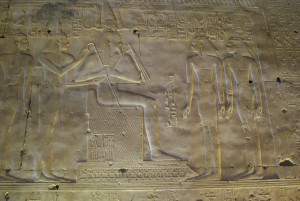
Osiris in an elaborate Atef crown, with arms opposing, holding Awet sceptre in right hand and crook and flail in left.
My first published comments on this topic appeared in 2009 (see note 1), and I have modified them only slightly since then. It is frequently assumed, in many ways quite logically, that in the case of kings, the crossed-arm pose of the mummy replicated the pose of Osiris because it was believed that the king became Osiris at death, just as his son and successor became Horus upon reaching the throne. Convenient though this interpretation is, it falls down under the most cursory scrutiny. Osiris is rarely shown in the crossed-arm pose. He is usually shown seated in profile holding a group of sceptres before him or, alternatively, seated with his torso turned to face the viewer, and grasping the crook in one hand and the flail in the other, the clenched hands almost meeting on the chest, and the sceptres resting on the shoulders. This latter pose is of most relevance here, since it is similar to, but distinct from, the crossed-arms pose. Sometimes the crook is in the left hand of Osiris, and the flail in the right hand, and sometimes vice versa. Sometimes Osiris holds two crooks or two flails.
As the pose of Osiris is so central to this article I felt that I should conduct a more thorough and exhaustive survey to try and reach more certain and quantifiable conclusions. It is, of course, near impossible to be truly exhaustive, and inevitably my findings are based on what I could find amongst my books, Journals, magazines and photographs, and upon material culled from the Internet, including web sites such as www.osirisnet.net (invaluable for scenes on tomb walls). It should be stressed that the left and right orientation mentioned here is that of Osiris himself, and not that of the viewer.
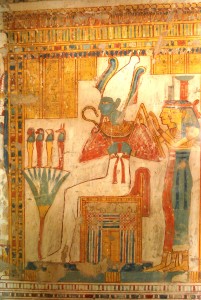
Osiris in a classic Judgement scene in the 19th Dynasty tomb of Neferenpet, Thebes, with arms opposing.
The task is, inevitably, much more complex than it might at first seem. For instance, it is necessary to distinguish between scenes depicting Osiris and those which are of the deified king. Osiris is not always named (at least not legibly in the sources available!) and may be alternatively, or in addition, known as Khenti-Amentui, Wennefer, Lord of Eternity, Lord of Djedu, Lord of Abdju etc. Apart from the precise positioning of the arms and sceptres, there might be some significance in whether Osiris is shown standing or seated, what crown he wears, whether or not he bears an uraeus, what colour his skin is, and the specific style and colour of his dress. It might also be suspected that there would be some correlation between the pose, and some of the other factors, and the role Osiris played in the scene depicted – the judgement of the dead, receiving offerings or prayers – and which deities accompanied him. Again, the location of the scene within the series of prayers and rituals on the walls of a tomb, or in a papyrus might be of importance; indeed, variations in the pose of Osiris, and/or the orientation of his sceptres may often be found in the same tomb or document (see note 2). One point that does arise is the parallel relationship Osiris appears to have in various places with Re-Horakhte, Sokar, or even Atum. Frequently Osiris and Re-Horakhte are shown seated on thrones, back-to-back, receiving offerings, and Re-Horakhte appears to exhibit a similar range of poses to Osiris. The reason, of course, may lie in the myth of the death and resurrection of the sun during the hours of night (see note 3).
In total I compiled 183 depictions of Osiris which derive from the following sources: royal tombs; nobles’ tombs; stelae; funerary papyri; Osiris shrouds; the decoration/vignettes on coffins and other funerary items; statues/figurines; temple walls; and others. With regard to era, I found the most useful groupings to be: 18th Dynasty; 19th/20th Dynasties; 21st/22nd Dynasties; Third Intermediate Period/Late Period; Ptolemaic/Roman. It is notable that in all my searches I did not find a single useful example predating the New Kingdom. Osiris is mentioned, of course, in funerary texts of the Old and Middle Kingdoms, but there does not seem to have been any urge to depict him figuratively (and, of course, we lack intact mummies of kings from these eras to compare with any such images). One rare exception, dating to the Old Kingdom, is seen in the mastaba of Medunefer at Balat in the Dahkleh Oasis. Here the small figure of Osiris (used as a determinative) is shown as a mummy wearing the white crown, wrapped to completely conceal the arms (see note 4).
Though depictions of Osiris before the 18th Dynasty are probably genuinely rare, the frequency with which I encountered examples from the Ramesside period (88) as compared to other periods, may reflect their genuine abundance. With regard to comparisons with the pose of royal mummies, it is the era from the start of the New Kingdom to the early 22nd Dynasty that is of relevance, and most (161 or 87%) of the examples I compiled are from this period.
Overall, it can be concluded that the current survey largely bears out the observations made above. Depictions of Osiris in profile remain a significant proportion of the total until the Ptolemaic period, but during the New Kingdom (and especially in the Ramesside era) the pose with clenched hands positioned ‘opposing’ one another on the chest is much the most common. Only in the 21st Dynasty does the crossed-arm pose (almost invariably right-over-left) become the most frequent. This is largely down to its appearance on Osiris shrouds and in funerary papyri of the period, though the ‘opposing’ pose is still much in evidence. By the Late Period the crossed-arm pose is overtaken as the most common by another – seen particularly on statuettes – where the hands are placed on the chest one above the other, with the right hand higher than the left.
It might be anticipated that, in scenes where Osiris is shown facing the viewer, the Heqa crook and the Nekhakha flail would each tend to be held in the same hand – for instance right holding flail and left holding crook – but this is not the case. In fact the sceptres seem as likely to appear in either hand, whatever the type of monument, irrespective of era, and regardless of whether the hands are ‘opposed’, crossed, or one above the other. An interesting variant is that Osiris will sometimes hold a long crook-like sceptre in one hand called the Awet. Apart from it’s length, the Awet differs from the crook in that the head is more open, something like that of a walking stick. Sometimes, in such scenes, the other hand will hold either flail or crook, or both.
It is curious that the only depiction of Osiris with crossed arms found from the 18th Dynasty comes from the door panels of the second shrine of Tutankhamun. Here the right arm of Osiris, bearing the flail, crosses over the left arm bearing the Awet sceptre. Clearly a lot more work is required to try and determine if there is any significance in the poses adopted by Osiris – with a particular choice of sceptres – on certain occasions; but it is clear that it cannot be said that the crossed-arm pose of New Kingdom royal mummies or royal statues is that of Osiris.
Osiride Statues
It is strange how subjects sometimes bring themselves to your attention. Long before I ever embarked upon this study, I was gazing absent-mindedly at the cover of an early (1972) edition of Cyril Aldred’s, Akhenaten Pharaoh of Egypt, and gazing back at me was one of the Gempaaten statues, from East Karnak. The distortions of these colossal statues have led to so much speculation over whether the king was afflicted with one of a variety of medical conditions (Fröhlich’s syndrome; Marfans syndrome; semi-blindness and numerous others), or perhaps a rather adventurous attitude to art. What caught my attention on this occasion, however, was not Akhenaten’s distorted physique, but the position of his arms.
“Why,” I asked Aidan Dodson, “was Akhenaten adopting the pose of Osiris? Surely, he had abandoned Osiris along with all deities other than the Aten!” “Probably this is not the pose of Osiris, adopted by Akhenaten,” he replied, “but rather, the pose of the king adopted by Osiris.”
So, in effect, the posture had become synonymous with kingship, and because Osiris was equated with the king, he had acquired royal attributes. It made sense, but actually Akhenaten was posed with his arms crossed, right-over-left, upon the chest, holding the flail in the right hand and the crook in the left. Each of the sceptres then crossed back to sit, flail on the right shoulder, and crook on the left. This is the ‘classic’ crossed-arms pose, as seen in the coffins of Tutankhamun, and as we have seen in the previous section, was not the pose of Osiris – certainly not until long after the time of Akhenaten.
Although the crossed-arms pose seems to have necessarily nothing to do with Osiris, the name ‘Osiride’ has been applied to a type of colossal royal statue where the body appears to be swathed and ‘mummiform’, as though dead, with arms crossed in this manner. These are to be seen as pilasters in the second court of both the Ramesseum and Medinet Habu – the mortuary temples of Ramesses II and Ramesses III – and may once have worn either the Atef or White crown. However, the regal statues in the crossed-arm pose which act as pilasters on the right-hand (north) side of the first court at Medinet Habu bear no resemblance to a shrouded mummy, and, as Bill Murnane pointed out, cannot claim any association with Osiris:
“The king is seen barelegged and garbed in a kilt with a falcon-pommeled dagger thrust into his belt. His arms are crossed, and he holds the crook and the flail, symbols of sovereign power. On his head is an elaborate version of the plumed and horned Atef-crown, with an anagram of the king’s throne name, “Userma’atre,” worked into the design… Although these statues are sometimes referred to as Osiride figures, everything seems to speak against this interpretation. The king as pictured here is in the full vigour of life, his appearance far from resembling the shrouded god of the dead. Osiris is not the only god who can wear the Atef, moreover, and the inscription on the base of one of the statues refers to this image as being “the sovereign, beautiful as king on the throne of Atum and wearing the Atef like Re-Harakhty.” All these inscriptions stress the king’s active role and his relationship with the other gods, so he is clearly to be viewed here as the archetype of Egypt’s divine king.” (see note 5).
Thus it would appear that the first court in these mortuary temples featured the living king, and the second court the dead king; and though he was represented in the second court as an ‘Osiris’, i.e. the deceased, in neither court did he represent Osiris. It would, of course, have been easy enough to portray the king in the true pose of Osiris had that been desired. In spite of this, and presumably in indifference to Murnane’s observations, statues – particularly large, standing statues – of the king in the crossed-arm pose are often referred to as Osiride, or as ‘in the pose of Osiris’, even when published in relatively serious works. The situation is certainly complex. There are statues of the king in the form of a mummy and resembling Osiris except for the fact that the arms are crossed, rather than ‘opposed’; there are standing statues of the king, with crossed-arms, in the costume of life; and then there are seated statues of the king in the same pose; and lastly representations of the king in the true, arms-opposed, pose of Osiris.
Mummiform Statues
Examples of mummiform statues are to be found in those of Senusret I from the 12th Dynasty, as displayed in the Cairo Museum; and the series depicting Thutmose I standing between the fourth and fifth pylons at Karnak. In both cases the arms are crossed on the chest, holding ankhs, and the king wears the white crown. A mummiform statue of Amenhotep I from Deir el Bahari has empty clenched hands and may imitate the form of Mentuhotep seen in his nearby temple (see note 6). The mummiform pilasters in the second court at the mortuary temples of Ramesses II and Ramesses III have been addressed above, but there is another series of mummiform statues/pilasters from a mortuary temple which are worth discussing at length.
The Hatshepsut Osirides
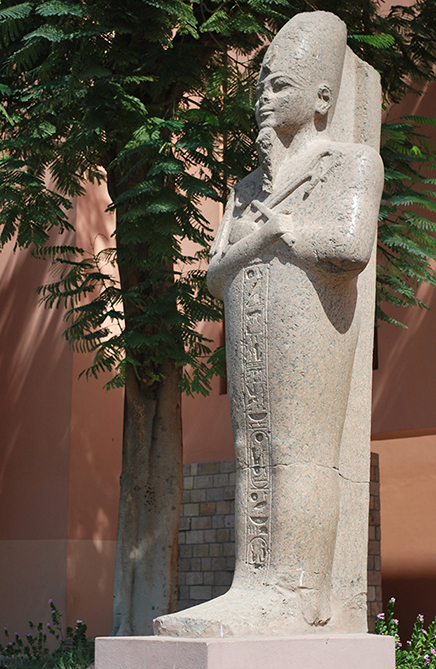 Standing in the grounds of Luxor Museum, just beyond the ticket barrier, is an interesting statue. Larger than life-size and made from granite, it depicts the king wearing the white crown of Upper Egypt, standing with legs together, his body apparently covered by a shroud – the style often referred to as ‘mummiform’. A column of text running down the front of the body gives the names and titles of Ramesses II (see note 7). As with other mummiform statues, the arms are crossed high on the chest, right over left, so that the right hand sits on the left breast holding a Flail sceptre that itself crosses back over the chest to sit on the right shoulder, and the Crook sceptre in the left hand similarly crosses to sit on the left shoulder. What is curious about this statue is that here – almost uniquely – the Flail in the right hand is joined by an Ankh, and the Crook in the left hand is joined by a Was sceptre. Further examples of mummiform statues/pilasters bearing this same pairing of sceptres are to be found in Hatshepsut’s mortuary temple at Deir el Bahari. There the pilasters lining the upper terrace wear the combined crown, but the colossal statues found at the back of the court below wear the white crown. The Ramesses II statue outside Luxor Museum is thus a smaller version of one of the lower court statues (and it may be that Ramesses II adapted it from an original of Hatshepsut), however, it is clear that Hatshepsut herself regarded the mummiform statue with the white crown and sets of dual sceptres as particularly significant, because it appears on a relief in her Red Chapel at Karnak (now reconstructed in the open air museum). Here she is depicted with Thutmose III offering before the temple of Djeser-djeseru (Deir el Bahari) which is fronted by a mummiform statue named Maatkare Beloved of Amun, wearing the white crown and bearing exactly the same arrangement of Flail and Ankh in the right hand, and Crook and Was in the left. The statue was thus, in some way, seen to epitomise the function of the temple at Deir el Bahari.
Standing in the grounds of Luxor Museum, just beyond the ticket barrier, is an interesting statue. Larger than life-size and made from granite, it depicts the king wearing the white crown of Upper Egypt, standing with legs together, his body apparently covered by a shroud – the style often referred to as ‘mummiform’. A column of text running down the front of the body gives the names and titles of Ramesses II (see note 7). As with other mummiform statues, the arms are crossed high on the chest, right over left, so that the right hand sits on the left breast holding a Flail sceptre that itself crosses back over the chest to sit on the right shoulder, and the Crook sceptre in the left hand similarly crosses to sit on the left shoulder. What is curious about this statue is that here – almost uniquely – the Flail in the right hand is joined by an Ankh, and the Crook in the left hand is joined by a Was sceptre. Further examples of mummiform statues/pilasters bearing this same pairing of sceptres are to be found in Hatshepsut’s mortuary temple at Deir el Bahari. There the pilasters lining the upper terrace wear the combined crown, but the colossal statues found at the back of the court below wear the white crown. The Ramesses II statue outside Luxor Museum is thus a smaller version of one of the lower court statues (and it may be that Ramesses II adapted it from an original of Hatshepsut), however, it is clear that Hatshepsut herself regarded the mummiform statue with the white crown and sets of dual sceptres as particularly significant, because it appears on a relief in her Red Chapel at Karnak (now reconstructed in the open air museum). Here she is depicted with Thutmose III offering before the temple of Djeser-djeseru (Deir el Bahari) which is fronted by a mummiform statue named Maatkare Beloved of Amun, wearing the white crown and bearing exactly the same arrangement of Flail and Ankh in the right hand, and Crook and Was in the left. The statue was thus, in some way, seen to epitomise the function of the temple at Deir el Bahari.
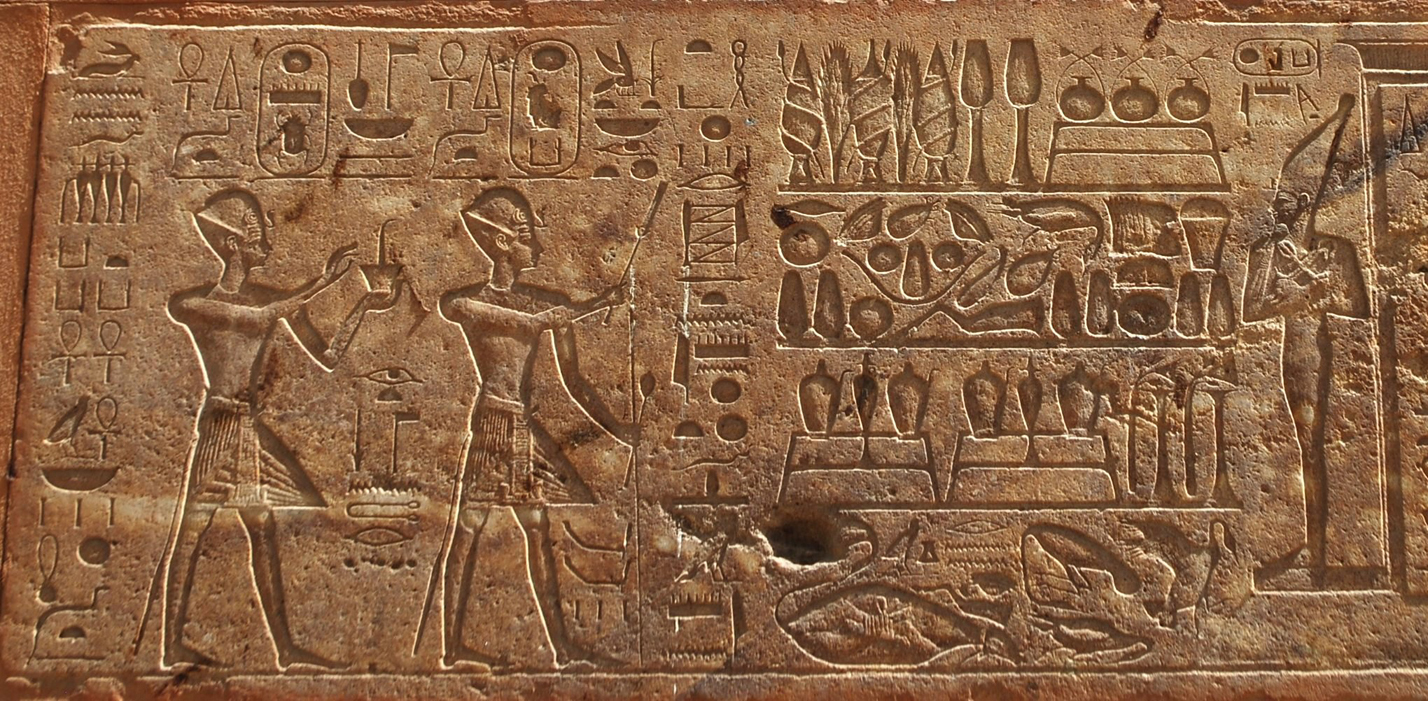
Red Chapel scene showingThutmosis III and Hatshepsut making offerings to the Temple of Deir el Bahari including a mummiform colossus
The Living King
Probably the best known standing statues of the king with crossed-arms, wearing the costume of life are the pilasters of Ramesses II inside the great temple at Abu Simbel. Here the right arm with crook is crossed over the left with flail; and on the south side the king wears the white crown, whilst on the north he wears the combined crown of Upper and Lower Egypt. Similar pilasters – with crook (right) crossed over flail (left) – lined the interior at Gerf Hussein, though here the king always wore the combined crown. The statues of Ramesses III in the first court at Medinet Habu had the same arrangement of arms and sceptres. However, the well-known statue of Pinudjem I in the first court at Karnak also sports the combined crown, but has the arms crossed flail (right) over crook (left). Earlier examples of the ‘living king’ form occur in the aforementioned colossal statues of Amenhotep IV (Akhenaten), which have the arms crossed flail (right) over crook (left), and appear sometimes to have worn the combined crown, atop either khat or nemes wigs; though the wig was alternatively sometimes topped by the feathers of the god, Shu.
The Seated King
The crossed arms pose – flail in right hand, crook in left – is seen as far back as the Old Kingdom in a seated statuette of Pepi I wearing the heb sed costume. The pose is again seen in statues of King Mentuhotep II, either standing or seated, with arms crossed right-over-left, but the clenched hands empty. The costumes depicted on these statues show that they probably relate to the king’s Heb Sed ceremonies. Seated statues also depict Sobekhotep V, and Thutmose II in Heb Sed costume with right arm bearing the flail crossed over the left holding the crook; the flail itself crossing over the crook (see note 8). An interesting variant is the statue of Amenhotep III being crowned by Amun, now in the Luxor Museum. Here the king kneels and wears the blue crown, his arms being crossed right (flail) over left (crook), and wears a garment something like the Heb Sed robe (see note 9).
The King in the Pose of Osiris
There are some depictions during the New Kingdom of the king in what was then the true pose of Osiris – with the clenched hands ‘opposing’ on the chest. This may be observed on talatat blocks of Amenhotep IV/Akhenaten as displayed in Luxor Museum and at Luxor Temple. Amenhotep III is shown in the same pose at Soleb, in Nubia, wearing the red crown and a long robe as part of the Heb Sed ceremony. Very similar scenes are to be found on blocks depicting Osorkon II celebrating the Heb Sed festival at Bubastis.
The overall impression is that the crossed-arm pose in statues of the king had something to do with an expression of his power and authority. However, there are a number of other statue-types that convey this impression – for instance, the striding king with hands clenched at his sides (as in the Memphis colossus of Ramesses II); the seated king with the right hand clenched and the left hand flat on his thighs (as in the Khafre statue in the Cairo Museum); and the seated king with the left hand flat on the thigh and right hand crossed over the chest with a crook held to rest on the right shoulder (as in the statue of Ramesses II in Turin). Probably then, the crossed-arm pose is something more specific, perhaps related to dominion over the Two Lands.
A suggestion is that the flail relates to the grain-producing lands of the Nile Valley, whilst the crook relates to the pastoral lands of the Nile Delta. With relation to the pose of the New Kingdom royal mummies, it did seem to be often the case that the Theban kings of the Eighteenth Dynasty crossed the right arm (flail of Upper Egypt), over the left (crook of Lower Egypt); whilst the early Nineteenth Dynasty kings, hailing from the Eastern Delta, reversed the position to place the left/crook dominant. It is interesting that when, in the later Nineteenth and early Twentieth Dynasties, the sarcophagus lid of the king began to be topped by a depiction of the dead king with crossed arms bearing sceptres, the crook always assumed the dominant position.
Most curiously, it was only after the end of the New Kingdom, in the period of the Theban priest kings that Osiris began to appear in the crossed-arm pose. Perhaps also in Thebes the flail began to assume its previous superiority.
Conversely, the rare occasions when the king was depicted in the true pose of Osiris – in the New Kingdom and after – it seems always to have been part of the Heb Sed ritual.
Further Research
It is clear that much more work is required to determine the exact significance of the pose of either Osiris or the king as depicted in specific monuments. It is perhaps likely that each king would have aimed to have had at least one example of a range of statues and/or reliefs depicting him fulfilling various important religious functions. Of course many kings may not have reigned long enough to achieve this, and accidents of survival make it hard for us to be sure what an ideal set of images might have comprised. It may also have been the case that kings changed their expectations over the course of history, and it is likely that Osiris similarly underwent changes as his importance changed and developed through the pharaonic period and on into the classical epoch. I hope I have done enough in this brief survey to suggest various avenues of profitable research that may be conducted in scholarly publications, museum collections, and upon the ground in Egypt; and I hope that some readers will feel encouraged to pursue some of the themes presented here, even if it is only to demolish any suggestions I have put forward.
Notes
1. Dylan Bickerstaffe, Identifying the Royal Mummies, Part 4 of Refugees for Eternity: The Royal Mummies of Thebes (2009).
2. Osiris appears in profile, opposing, and one-hand-higher poses in the papyrus of Nestanebtishru, for instance.
3. On two 22nd Dynasty coffins in the New Walks Museum, Leicester, Osiris receives the deceased, but it is Re-Horakhte who presides over the weighing of the heart.
4. See the photograph in Aidan Dodson and Dyan Hilton, ‘The Oases of Egypt’s Western Desert. Part One’, KMT 20.1 (Spring 2009), 62.
5. William J. Murnane, United with Eternity A Concise Guide to the Monuments of Medinet Habu (AUC Press 1980), 21.
6. N. Strudwick, Masterpieces of Ancient Egypt, (British Museum, London 2006), 126; discusses this piece in the British Museum. This is an example where the statue is said to be in the pose of Osiris.
7. ‘Horus, Strong Bull Beloved of Maat; Nisw Bity, Lord of the Two Lands (Usermaatre Setepenre); Son of Ra, Lord of Appearances, (Ramesses Meryamun).
8. D. Forbes, ‘Akheperenre Djehutymes The All-But-Forgotten Second Thutmose’, KMT 11.2, (Summer 2000), 67; also Sobekhotep V CG42027 in A. Dodson and D. Hylton, The Complete Royal Families of Ancient Egypt (London 2004), 106.
9. See Ayman Wahby Taher, ‘New Display at Luxor Museum’, Ancient Egypt 43 (8.1, Aug/Sept 2007), 20-21. This issue also includes a useful Photo Feature by Bob Partridge, ‘Colossal Statues of Akhenaten from the Temple of Karnak’, 30-36.
Image Credits
All images copyright Dylan Bickerstafffe

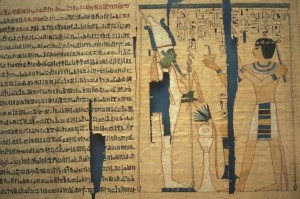
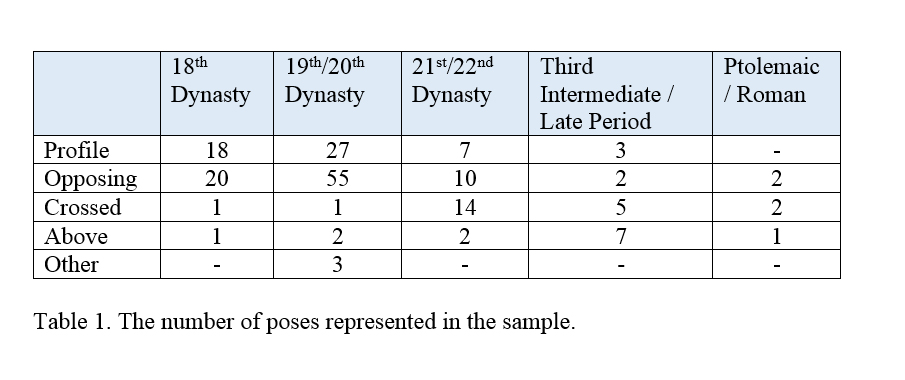
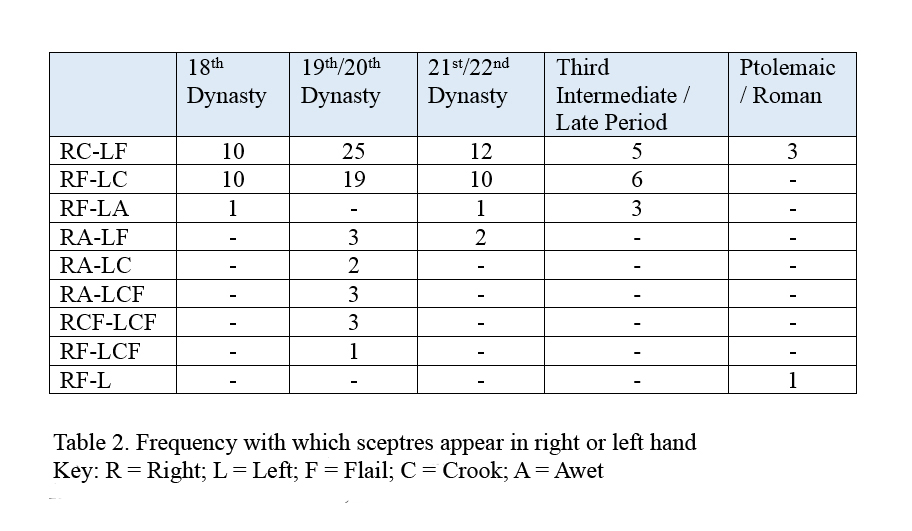
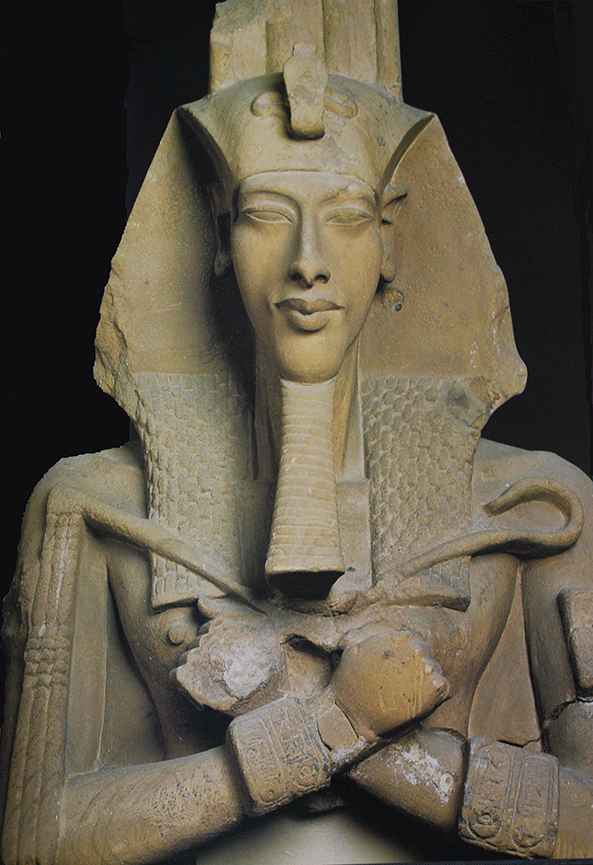
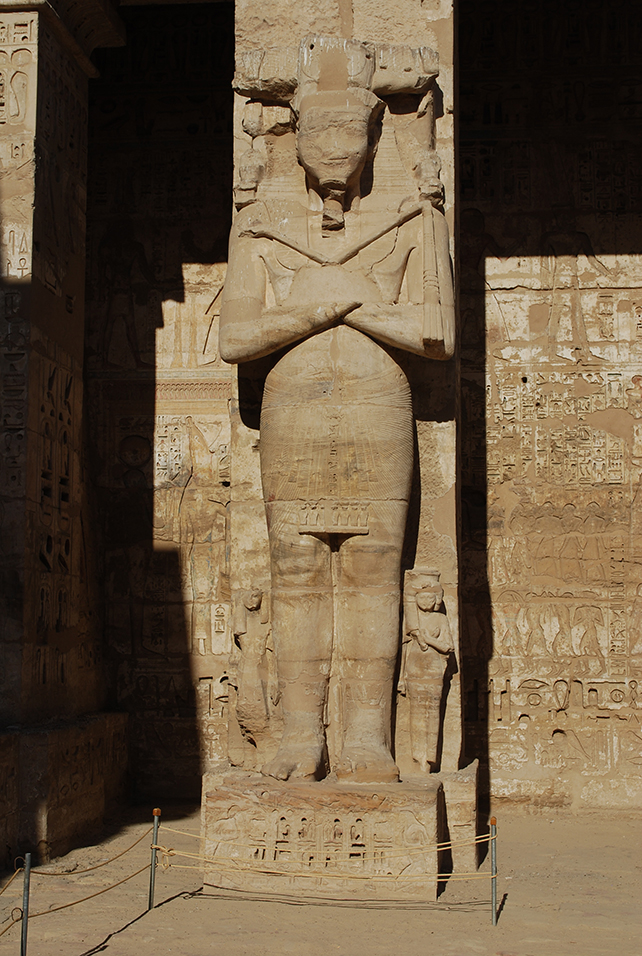
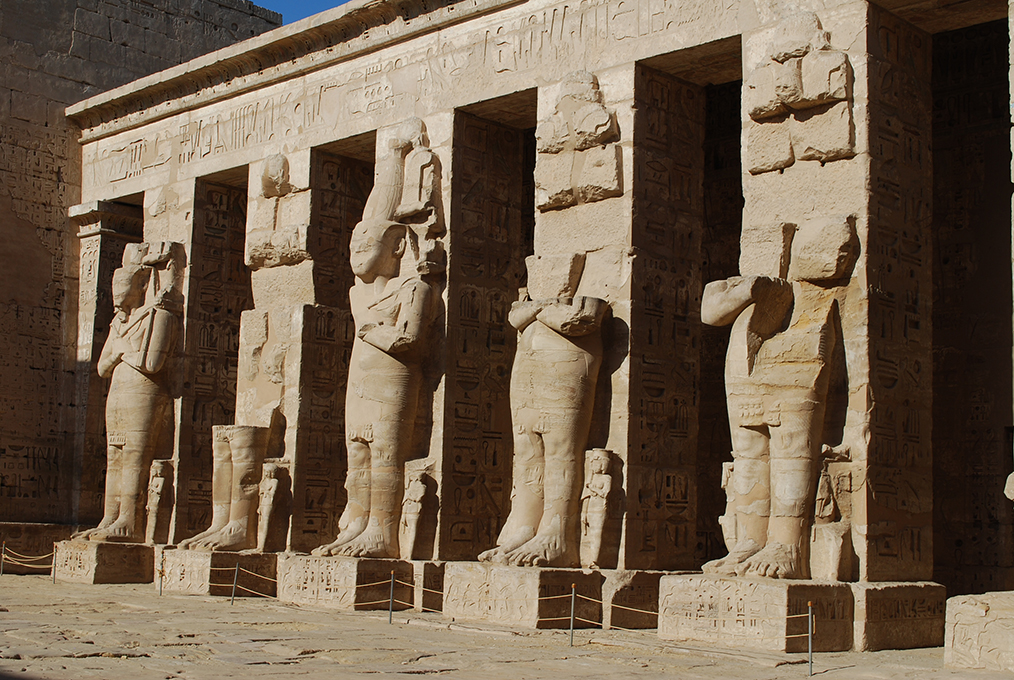
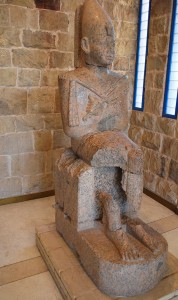
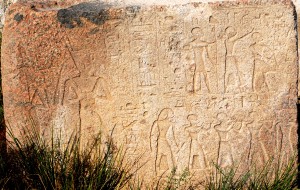

 By
By